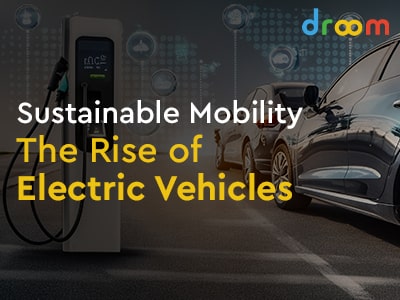Recently, everyone has been quite intrigued by the marvelous design and technology wrapped around electric vehicles. EVs are simply not a mode of transportation anymore, but a call to attain luxury by being careful towards your surroundings and a cleaner environment. Due to this major shift, the automobile industry that too in the EV lineup is witnessing a huge surge, projected to experience a boost of 18.2% CAGR from 2021 to 2030, ultimately making a stop at $823.75 billion (Allied Market Research).
EVs are transforming mobility by cutting emissions and paving the way for a greener future. There are still a huge number of hurdles in the way of a sustainable transportation revolution, even after having a boatload of benefits. This blog examines the quick rise of electric vehicles (EVs), their effects on the environment, and the barriers to their widespread adoption.
In this blog, we’ll cover:
- The Rise of Electric Vehicles
- Government Support and Policies
- Advancements in Electric Vehicle Technology
- Business Automation Software
- Cost Reduction and Financial Incentives
- Sustainable Mobility Ecosystem
- Challenges and Opportunities
- Wrapping Up: Shaping the Future of Mobility
The Rise of Electric Vehicles
Electric vehicles have been settled as a prime solution in striving against any kind of environmental challenges masqueraded by conventional fuel-powered automobiles. With null and void tailpipe emissions and an overall less carbon footprint, EV vehicles offer a more sustainable and cleaner alternative for both personal and commercial use. The benefits of switching to electric mobility have been recognized by businesses, consumers, and governments worldwide, hastening the adoption of electric vehicles due to their growing affordability, range, and performance.
Government Support and Policies
Government is working round the clock to provide the utmost support and conducive policies to enhance overall EV adoption. Numerous countries are providing incentives like tax credits, rebates, and subsidies to motivate people to switch to electric vehicles as their mode of transportation. Additionally, governments are investing money in building infrastructure for charging ICE vehicles and designing some policies to limit sales of new fuel-based vehicles in the future. Such actions are fostering a favorable atmosphere for the expansion of the EV sector.
Advancements in Electric Vehicle Technology
Electric vehicle (EV) technology is surging, making EVs more efficient, reliable, and affordable. Battery advancements, charging network growth, and innovative designs tackle range anxiety, fast charging needs, and initial costs. This positions EVs as a realistic choice for everyday use. From long-range cars to electric buses and trucks, the variety of EVs keeps growing, meeting diverse transportation demands.
Business Automation Software
Technology advancements coupled with business automation software become an unbeatable pair to ultimately streamline operations, strategize innovation, and boost overall productivity in the EV lineup. These aforementioned solutions offer support to the manufacturers by optimizing the production processes, handling logistics and supply chains and enhancing overall operational efficiency.
If recurrent tasks are automated, workflows are digitized and data is centrally managed, manufacturers automatically become a huge contributor toward cleaner, greener India. Doing all this will reduce humongous waste, less the use of paper, and lower the overall environmental footprint caused by the production of electrical vehicles.
Cost Reduction and Financial Incentives
Slowly and steadily, demand for electric cars, electric scooters, etc. is surging. Instead of this, scalable economies are supporting bringing down the overall production costs, specifically that of batteries and EV components. This step tunes down the cost of electric vehicles. Furthermore, owning an EV comes with its charm.
EV owners supposedly acquire less operating and maintenance costs as compared to fuel-based vehicles with the reduced usage of fuel and maintenance expenses. Several regions offer incentives such as less or completely waived toll charges, supposed access to some restricted areas, and parking discounts, further alleviating the financial support of EVs.
Sustainable Mobility Ecosystem
Technology wrapping electric vehicles goes way beyond singleton vehicles to enclose a comprehensive sustainable mobility ecosystem. You couldn’t be more wrong if you believe that EVs are simply a distinct mode of transportation. They are way more than that. Electric vehicles are a carefully curated amalgamation of renewable energy integration, smart charging infrastructure, and well-managed transportation networks.
By taking advantage of AI, data analytics, and connectivity, EVs can easily be amalgamated into smart grids, ultimately optimized for energy efficiency, and synchronized with various modes of transportation to provide a mobility experience that is both sustainable and seamless.
Challenges and Opportunities
Everything comes with its share of highs and lows. The same is the case with EV vehicles. Some of the crucial challenges that need to be addressed before the complete adoption of electric vehicles are:
- Recycling of EV batteries
- Expansion of Charging Infrastructure
- Availability of Government Policies
- Consumer Awareness
Wrapping Up: Shaping the Future of Mobility
Electric vehicles are for sure going to be a step closer to achieving a cleaner, greener future with a sustainable mode of transport. One can easily reach a step closer by finding a perfect blend between technology, infrastructure, and EVs. At Droom, we believe in contributing our equal share towards achieving a cleaner, greener future. You can check out droom.in for different models of your choice within your budget.
